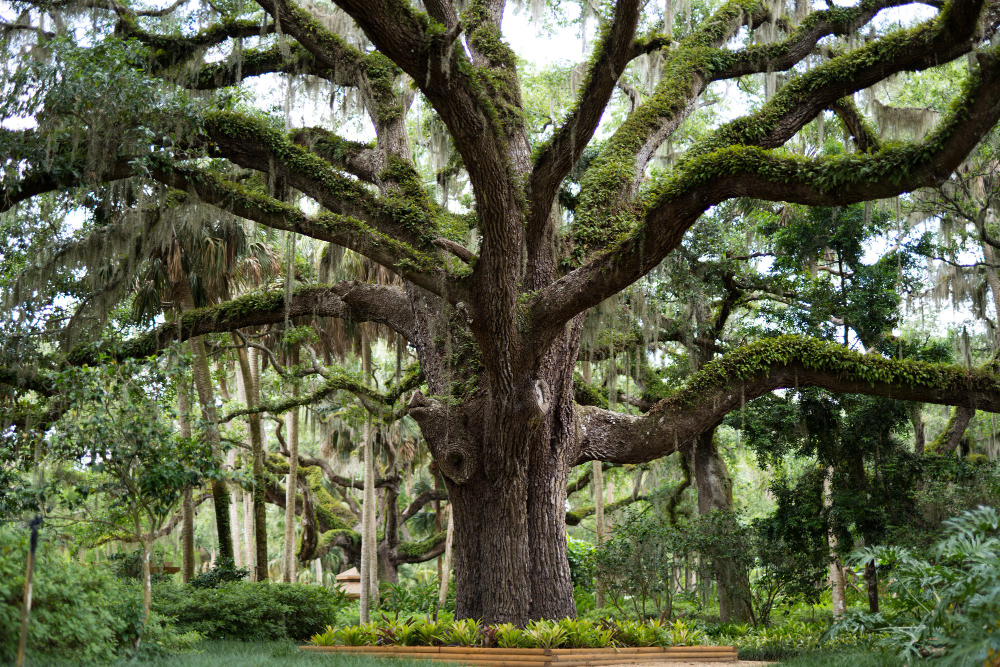Beneath the emerald arches of our planet’s forests, there exists a realm teeming with whispers and alliances, a world not of fantasy but of fascinating scientific discovery. This is the secret life of trees, that’s beginning to unfold with every rustle in the forest.

Image by: wirestock from Freepik.com
Table of Contents
The Secret Life of Trees: Communication and Cooperation
In this intricate understorey, trees—those silent, stoic giants we often admire for their beauty and magnitude—are actually at the heart of a bustling network. They communicate and cooperate through a system so complex and sophisticated, it mirrors the intricacies of a human society.
For a long time, the life of trees was believed to be solitary; each tree striving for sunlight, drawing nutrients from the soil independently. However, recent studies have unveiled a remarkable truth: trees are far from silent in their existence. They communicate through the “Wood Wide Web,” an underground network of fungi known as mycorrhiza. This symbiotic relationship between the fungal networks and tree roots allows for a highway of communication that is breathtaking in its complexity.
A tree at one end of the forest is attacked by pests. Through the network, it sends out chemical signals. These signals are picked up by neighboring trees, which then preemptively boost their own production of pest-repelling chemicals. It’s a forest-wide alarm system, a communal effort to thwart a common enemy.
But the conversation doesn’t stop with defense mechanisms. Trees share nutrients through these fungal conduits, a testament to their cooperative spirit. In times of scarcity, healthy trees will funnel sugars to the sick and the fragile, ensuring the collective well-being of the forest. This mutual assistance extends to the sharing of information, allowing trees to manage resources, like water and nutrients, most efficiently.
Perhaps most fascinating is the role of ‘mother’ trees, or hub trees. These elderly, well-connected individuals act like anchors for the forest, supporting numerous other trees. By distributing resources to their saplings, they ensure the survival and continuity of their species. Their loss, due to logging or environmental degradation, can have devastating effects on the forest ecosystem, underlining the importance of these arboreal elders in the woodlands’ social fabric.
This intricate tapestry of interactions fosters not only the survival but the thriving of forests. It’s a reminder that trees, much like humans, rely on communication and cooperation for their well-being. This revelation shifts our perspective, inviting us to view forests not just as collections of individual trees but as dynamic, interconnected communities.
The secret life of trees opens our eyes to the remarkable ways in which these majestic entities support each other and the ecosystem at large. It challenges us to reconsider our relationship with these silent sentinels, encouraging us to protect and preserve them for generations to come. As we delve deeper into understanding their hidden lives, we uncover not only the complexities of their existence but also the broader implications for biodiversity and our interconnected world.
In essence, the forest teems with life and communication, a veritable society standing tall against the sky, whispering the ancient secrets of survival, cooperation, and resilience.
The Wood Wide Web: A Network of Connectivity
Central to the concept of tree communication is the “Wood Wide Web,” a term that encapsulates the intricate system of symbiotic relationships between trees and mycorrhizal fungi. These fungi form networks of fine filaments, called mycelium, that connect the roots of different trees, creating a vast, underground web through which they can exchange nutrients, water, and crucial information about their environment.
Scientists have found that through this network, trees can send distress signals about environmental stressors such as drought or disease, enabling other trees to adjust their behavior accordingly. This remarkable form of communication highlights the trees’ ability to function not as isolated individuals but as a cohesive, interdependent community.
Venturing beneath the forest floor, where a hidden realm thrives, not of roots and soil, but of an intricate network dubbed the “Wood Wide Web.” This fascinating world, unseen to the naked eye, is where trees whisper secrets to one another, not through the rustling of leaves, but through an extensive underground network formed by mycorrhizal fungi. These fungi, with their fine filaments called mycelium, weave a tapestry of connectivity among the towering giants above.
This web is not merely a mesh of connections but a thriving conduit for conversation and communal support. Trees, through these fungal networks, engage in a sophisticated form of exchange, sharing nutrients and water with those in need. But the exchange doesn’t stop at material goods. The Wood Wide Web serves as a neural-like network, carrying distress signals across vast distances. When a tree faces threats, such as encroaching pests, diseases, or the harsh grip of drought, it sends out a chemical SOS through the network. This message, subtle yet urgent, alerts its neighbors, prompting them to bolster their defenses, alter their resource allocations, or, in the case of impending drought, conserve water.
This ability to communicate distress and share resources signifies a monumental shift in how we perceive trees. Far from the stoic, solitary figures we once thought them to be, trees within a forest act as a cohesive, interdependent community. They are not merely surviving but are actively supporting one another, akin to a family that shares its resources and knowledge for the benefit of the collective.
The discovery of the Wood Wide Web has illuminated the profound interconnectedness of forest ecosystems. Trees, through their underground alliances, form a network of support and information that is as complex and nuanced as any human society. Scientists are only beginning to unravel the full extent and implications of these connections, but what is clear is that these communications underscore the importance of viewing forests not as collections of individual trees but as dynamic, interconnected systems.
The Wood Wide Web challenges our traditional notions of biology, urging us to rethink our relationship with the natural world. In recognizing the communal lives of trees, we are called to appreciate the delicate balance of nature and the importance of preserving these intricate networks. Thus, the Wood Wide Web is not just a phenomenon of the natural world; it is a vivid reminder of the interconnectedness that sustains all life on Earth, urging us to act with greater care and respect for these complex ecosystems that support our very existence.
The Language of Leaves: Chemical Signaling
In addition to the underground networks, trees communicate through the air, using complex chemical signals. When a tree is attacked by insects, it can release specific chemicals that not only make its leaves less palatable to the invaders but also signal neighboring trees to boost their own chemical defenses. These aerial messages, akin to airborne pheromones, underscore the sophisticated ways in which trees interact with and protect each other.
Within the verdant whispers of the forest, a remarkable dialogue unfolds, not through sounds or gestures, but through the language of leaves—chemical signaling. This form of arboreal communication reveals a sophisticated and interconnected world that thrives in silence. Trees, often perceived as solitary sentinels of the natural world, engage in an intricate airborne networking that is as fascinating as it is vital for their collective survival.
A tree, standing tall and proud, its branches swaying gently in the breeze. Suddenly, it finds itself under siege by a troop of insatiable insects, eager to feast on its lush foliage. In this moment of peril, the tree activates an ancient, ingenious defense mechanism. It begins to synthesize and release a bouquet of specific chemicals into the air. These are not random emissions but carefully crafted signals—messages encoded in the very essence of its being.
The chemicals serve a dual purpose. First, they imbue the tree’s leaves with a taste that is utterly repulsive to the invading insects, thwarting their banquet before it can cause further damage. But the magic of these chemical signals extends far beyond the tree’s own leaves. Like whispers on the wind, these signals drift through the forest, reaching the sensory receptors of neighboring trees.
Upon receiving this chemical missive, the neighboring trees perceive the urgency and the nature of the threat. They, too, start conjuring their own alchemical brew, enhancing their chemical defenses before the insects can spread to their branches. This preemptive strike, coordinated through the air, illustrates a remarkable level of cooperative intelligence and communal protection among trees.
What we witness in this silent, unseen communication is a form of symbiotic solidarity. The trees, through their language of leaves, create an interconnected network of support, where the well-being of one contributes to the resilience of all. It’s a testament to the sophistication of nature, where even the seemingly mute elements engage in intricate dialogues.
This aerial chemical signaling, akin to airborne pheromones, underscores the rich, communicative exchanges that permeate the natural world. It reveals trees not as isolated entities but as participants in a vibrant, interconnected community. Their language, though silent to our ears, speaks volumes about collaboration, defense, and the evolutionary wisdom embedded in the forest’s very fabric.
In exploring the language of leaves, we uncover more than just the survival strategies of trees. We unravel the intricate tapestry of life that flourishes in the canopy and beneath, a tapestry woven through chemical signals that resonate with the essence of interconnected existence. The forest, in its majestic silence, resonates with a complex language of survival, resilience, and community, teaching us the profound value of communication and cooperation in sustaining life.
The Role of Mother Trees
Central to these forest networks are “mother trees,” the largest and oldest trees that serve as anchors for vast underground networks. Mother trees play a crucial role in forest ecology by nurturing younger trees and distributing resources more evenly throughout the community. They are capable of recognizing and supporting their offspring, channeling more nutrients to them via the mycorrhizal network. This relationship exemplifies the trees’ capacity for recognition and the altruistic behavior that contributes to the resilience of forest ecosystems.
The role of mother trees in forest ecosystems transcends mere existence; they are the nurturers, the caretakers, and the unsung heroes of the arboreal world. Their roots, intertwined with a network of fungal threads, create an underground marketplace where nutrients and water are exchanged for sugars produced by the trees. This marketplace, however, is not driven by competition but by the altruistic spirit of the forest. Mother trees, with their extensive networks, distribute resources with remarkable discernment, ensuring the well-being of the community at large.
What sets mother trees apart is their remarkable ability to recognize and prioritize their kin. Through the mycorrhizal network, they channel more nutrients to their offspring, fostering a new generation rooted in the legacy of their ancestors. This act of recognition and support is not merely an exchange of goods but a testament to the trees’ capacity for what can be likened to affection and care.
The altruism of mother trees extends beyond their immediate family. In times of distress, when they are wounded or dying, they disperse their life’s essence into the network, a final act of generosity to nourish and strengthen the survivors. This selfless behavior underscores their pivotal role in enhancing the resilience of forest ecosystems. It highlights the interconnectedness of life, where every entity, no matter how small or seemingly insignificant, plays a role in the grand narrative of the natural world.
The existence of mother trees challenges our understanding of communication and social networks in the natural world. They remind us that the forest is not merely a collection of individual entities competing for resources but a complex, dynamic community capable of empathy, planning, and even sacrifice. This intricate dance of give-and-take, mediated by the mother trees and facilitated by the mycorrhizal networks, is a powerful testament to the interconnectedness and interdependence of all life.
By looking closely at the role of mother trees, we are offered a glimpse into the intricate and intimate world of forest ecosystems. Their story invites us to reevaluate our relationship with nature and recognize the deeper, often invisible connections that bind us all. In the presence of a mother tree, we stand not just beneath a towering figure of the natural world but also at the heart of life’s enduring mystery and magic.
Mutual Support and Resource Sharing
Beyond mere communication, trees exhibit remarkable forms of cooperation and support. Older, larger trees, often referred to as “mother trees,” play a pivotal role in forest ecosystems, sharing resources through the Wood Wide Web with younger, less established trees. This resource sharing helps to ensure the survival and health of the younger generation, promoting a stable and resilient forest community.
Research has shown that this cooperation extends to sharing vital nutrients and even water, helping the entire forest to better withstand periods of scarcity or environmental stress. The existence of this shared economy challenges our traditional view of trees as solitary entities, revealing a complex, interconnected society that thrives through collaboration.
Conclusion
The secret life of trees, with their capacity for communication and cooperation, is a testament to the complexity and sophistication of natural systems. As we delve deeper into understanding these processes, we gain not only insights into the resilience and functionality of forests but also valuable lessons on the importance of community and mutual support. The hidden world beneath the forest canopy invites us to reevaluate our relationships with these living beings and the natural world at large, emphasizing the necessity of preserving these precious ecosystems for future generations.
In exploring the fascinating dynamics of tree communication and cooperation, we uncover a world where every tree contributes to a larger narrative of connectivity, resilience, and mutual support, reminding us of the intertwined fate of all living organisms on this planet.
By exploring and appreciating the secret life of trees and their complex networks, we gain insight into the essential role of forests in sustaining life on Earth. This knowledge encourages responsible stewardship of natural resources, ensuring that we preserve these vital ecosystems for future generations.
Frequently Asked Questions (FAQs) About - The Secret Life of Trees
Trees communicate through a complex underground network often referred to as the “Wood Wide Web.” This network is made of fungi called mycorrhizal fungi which connect the roots of different trees. Through these connections, trees share nutrients, water, and even send distress signals about pests and diseases.
While trees don’t talk in the human sense, they do exchange information in a way that’s analogous to communication. This occurs through chemical, hormonal, and slow electrical impulses through the mycorrhizal networks beneath the soil, as well as through the air using volatile organic compounds.
Yes, trees support each other by sharing resources such as nutrients and water through their root systems interconnected by mycorrhizal fungi. Moreover, healthy trees have been shown to support stressed or ill trees by supplying them with nutrients, thus ensuring the survival of the forest.
Research has suggested that some tree species can indeed recognize their relatives through root interactions and tend to share more resources with them compared to non-related individuals. This phenomenon suggests a sophisticated level of social interaction and cooperation among trees.
Understanding how trees communicate and support each other is crucial for developing sustainable forestry practices, restoring ecosystems, and combating climate change. By mimicking or preserving these natural networks, we can enhance the resilience of forests and their ability to sequester carbon, thus contributing to the health of our planet.
Tree communication and cooperation bolster forest resilience by spreading warnings about pests and diseases, allowing other trees to preemptively boost their defenses. This interconnectedness supports a balanced ecosystem, promoting biodiversity and the survival of various plant and animal species.
While the extent and methods of communication may vary, the ability to communicate and form networks is a widespread phenomenon among trees and plants. These sophisticated interactions have been observed across different biomes and tree species, highlighting a fundamental aspect of plant biology.
Preservation efforts can include protecting old-growth forests, supporting reforestation with a focus on native species, reducing deforestation, and promoting practices that do not disrupt the soil and its fungal networks. Educating others about the importance of these networks also plays a critical role in their conservation.




























